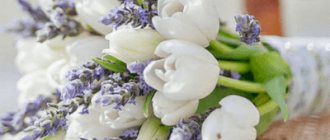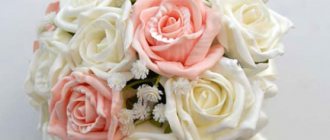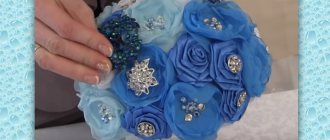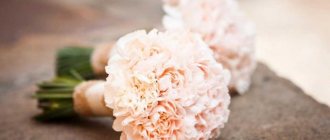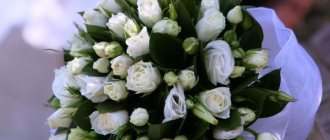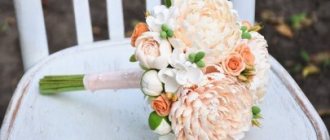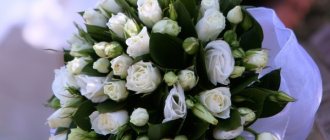Choosing a bridal bouquet is no less, and maybe even more difficult, than choosing a wedding dress. A clear idea of how it should fit into the image of the bride, what types of wedding bouquets there are and what role each of them should play will help you not to get confused when looking at the possible options.
Role
The bouquet is an integral part of the bride’s image, and therefore the unified image of the newlyweds. It can add tenderness or emphasize discreet elegance, be an elegant addition or act as a bright, attention-grabbing accent, become a symbol of fun or discreet solemnity of the moment.
Must be selected taking into account:
- place and time of the wedding;
- styles and colors of wedding dresses;
- appearance of the bride and groom;
- preferences of the bride and groom;
- will there be other flowers in the dresses of the bride and groom, as well as bridesmaids;
- what flowers will be used to decorate the hall;
- Will the groom have a boutonniere?
There are dozens of types of wedding bouquets for the bride, but their choice primarily depends on the type of arrangement.
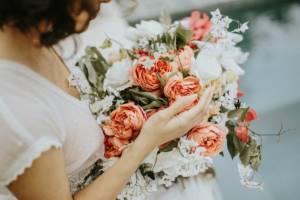
Possible assembly options are below.
- Collected from stems. These look simple and elegant, they are inexpensive, durable and non-traumatic, but the flowers can quickly wither.
- In a portaquet. A more complex, but also more durable option. Flowers are stuck into a damp sponge, which allows them to remain fresh longer. This type of assembly allows you to create complex options, but they are quite heavy and can cause injury to the girls who catch them.
- Taped. These bouquets are assembled from flowers, the stems of which are first cut off, and the flowers are attached to wire. Taped ones allow you to show creativity, but they are expensive, can quickly wither, and it is not advisable to throw them away.
Interesting! According to tradition, a wedding bouquet is a gift from the groom to the bride, so the groom must choose it and give it before the wedding ceremony. In order for the groom to choose the right one, you can tell him or his relatives or friends about your wishes.
Choosing the type of bouquet
Before you settle on one, you can consider different types of wedding bouquets: from the usual to the non-trivial.
Classical
It is also called round. Looks advantageous with any type of figure and bride's dress. The buds of different sizes, which begin to bloom one after another, look especially impressive. There is no need to lavishly decorate a classic bouquet.
Disheveled
The unconventional look is coming into fashion, usually appearing in ensembles with understated outfits. Being multi-level, it allows you to include any flora - fern leaves, branches, ears of corn and berries can be used.
Flower ball with handle
The form, popular in Europe, has gained recognition in Russia. The small, handy bouquet was invented as an alternative to the petals showered on newlyweds. The composition hangs on the newlywed's hand like a handbag. The handle holder is made of fabric, a string of beads or a chain. Florists use a dry or wet sponge to hold the pieces.
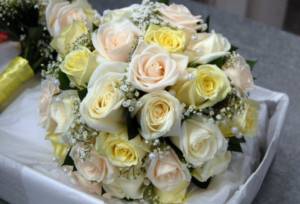
Long-lasting or artificial flowers are appropriate: the bouquet should remain beautiful all day and look good in photographs. A good choice for a winter wedding.
Cascade
Suitable for a tall, slender bride in a modest dress. The basis is a game with different lengths of stems. When flowers with short stems are placed at the bottom, and others with long stems seem to fall on top of them, the result is a “waterfall”. If short flowers arranged in layers on top cover long ones below, it is a “drop”.
Traditional materials for these compositions are roses, lilies, and freesias.
Fan bouquet
A wedding accessory for a romantic and confident person. On a wooden, wire or cardboard frame, flowers with stems without leaves are arranged in a circle. Fans are decorated with rhinestones, shells, beads or typhoid leaves. To keep them looking fresh, a flask with water is built into the composition.
Heart shaped
The same applies to frame compositions. The basis can be a cardboard box or piaflor, mounted on a foam base. Particular attention is paid to the durability of flowers - the “heart” should not fade quickly.
Glamelia
One of the most complex compositions in modern floristry, which not every specialist can do. Flower petals of the same or different species are combined to form one large flower. He looks incredibly elegant. Compilation is painstaking work, the price of the service is quite high.
From wild flowers
Suitable if the wedding is in the summer. Simple flowers - delphinium, violet, bell and dandelion - will make the bride's appearance touching. Almost no material costs, easy to make.
Original
For unconventionally thinking newlyweds. The design or components may be unusual. The main decoration of the bride today can not only be bought, but also sewn, knitted, or made from Christmas tree garlands.
Types by season
One of the important criteria when choosing is the time of the wedding. Spring ones are most often gentle and neat. They can include tulips, daffodils, lilies of the valley, irises, hyacinths, and mimosa. Options with flowering trees/shrubs (apple tree, cherry tree, bird cherry, lilac) are possible. Summer ones are usually full of colors. They can use wildflowers: peonies, daisies, lilies, poppies, sunflowers, and various herbs.

For autumn they like to use all shades of yellow and orange. To add more brightness, you can include rowan or viburnum berries, yellowed leaves and dried flowers. Traditional flowers are: dahlias, marigolds, asters, hydrangeas. Winter varieties of bridal bouquets combine flowers that are available all year round: roses, orchids, chrysanthemums, gypsophila, gerberas. Spruce and thuja branches look great in winter.
Possible forms
It is advisable to choose the form when the style of the bride’s dress and the venue of the celebration have already been chosen.
There is a huge variety of shapes for wedding bouquets.
- Round. With this shape, the flowers are located tightly to each other and form a semicircle. They are usually small in size.
- Biedermeier. Such bouquets resemble round ones, but the flowers in them are arranged in the form of rings, with one flower ring surrounding the next.
- Cascading or falling. Their shape resembles a waterfall. Cascade. They are collected from climbing flowers with strong flexible stems, such as climbing roses, orchids or lilies.
- Vertical. They are collected from flowers with long stems. As a rule, vertical bouquets are practically not decorated; only a ribbon is used to tie the stems together. Usually brides hold such bouquets, placing them along one hand.
- In the shape of a ball. The name of this form speaks for itself: the flowers are attached to a base located inside the bouquet, forming a ball shape. So that the bride can hold the bouquet, a chain or ribbon is attached to it.
- Glamelia (lilymelia, rosamelia). This form cannot be called a bouquet in the full sense of the word, since it represents one large flower collected from petals of several flowers glued together.
- Fantasy. These are bouquets of a wide variety of shapes. Among the most popular are in the form of a fan, heart, butterfly, umbrella, handbag, basket, corsage (bracelet).
Important! When choosing, you need to take into account the bride's build. For example, short brides should avoid very long bouquets, and girls with curves should avoid small round ones.
Round bouquet
This is a classic wedding bouquet, which most often includes flowers such as roses, peonies, hydrangeas and tulips. Great for classic ceremonies.
pros
- Beautiful and aesthetic classics have an advantageous shape, due to which a greater feeling of festivity is created.
- The bouquet has a convenient base, so it is not difficult to hold in your hands.
- Pairs perfectly with any flowers, from roses to daisies.
- There are many options for additional decorations, such as greenery, berries, beads or ribbons.
- There are many specialists who have experience in creating this kind of bouquets.
Editor's choice: Wedding without a script: alternative ideas
Minuses
- This bouquet is made using a special design, which gives it much more weight.
- It is very difficult to make a bouquet of this type on your own the first time; you need experience.
- The bouquet turns out to be expensive due to the additional work of the florist.
Monobouquets and prefabricated ones
Depending on whether only flowers of one type or several will be added, they are divided into mono-bouquets and prefabricated (mixed) bouquets. Mono bouquets seem more classic, simple and minimalist, while mixed bouquets seem more unique, bright and unusual.
Flowers in a mono-bouquet can be either the same or similar shade, or different. Leaves and various accessories can be added to bouquets consisting of one type of flower.
Flowers in prefabs are selected according to the length of the stem. Mixed ones can use flowers of the same shade (or the same degree of saturation, for example all pastel colors), or multi-colored ones.
Form of bouquet arrangement
This is the most important parameter; the effect produced by the bride on others depends on it. There are several key rules:
- short girls only need compact arrangements;
- with curvaceous figures, the bride needs to choose a large bouquet with predominant vertical lines;
- a princess-style dress and a voluminous floral accessory are incompatible;
- The simpler the outfit, the more unusual the floral design can be.
Hemisphere
Arrangements of a semicircular shape with a dense, geometrically regular “cap” can be called timeless classics of the wedding genre. They are always in fashion, or rather beyond its whims. A round bridal bouquet is universal and suitable for any girl, regardless of height, build and color type.
It’s hard to name a dress style that doesn’t look good with a hemispherical composition. However, A-line styles or those with a full, multi-layered skirt especially benefit from this “neighborhood”.
“Hemisphere” is harvested both on its stems and on the porta bouquet. In the first case, the composition can be freer, as if “disheveled”, with plants placed at different heights. In the second, the boundaries are correct and clearly defined, complete symmetry is maintained.
Typically, small flower buds are used for round arrangements.
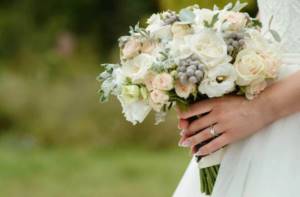
Cascade
Majestic compositions of a cascading shape, in which part of the flowers are directed downwards and form an inverted triangle, are suitable only for tall brides. The rest will be lost against the backdrop of buds of different shapes, sizes and textures falling like a stormy stream.
The “cascade” consists of a round “cap” and the so-called “tail” of plants on long stems, climbing grasses and flexible branches of shrubs. Most often, it is assembled on a portaquet or using a taped technique - this makes it easier to form a drooping silhouette. Although recently varieties “on their own stems” have appeared.
Cascading arrangements look good with a classic long, fitted dress.
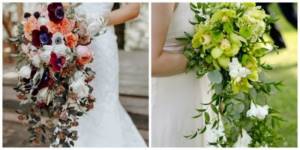
A drop
A compact version of the “cascade”, more convenient and practical. It can consist solely of flowers or be combined with greenery. Unlike the “cascade”, the “drop” is often collected from one type of plant. Roses, lilies, orchids, gardenias and eustoma are ideal for her.
“Drop” is good for a palace or romantic style wedding celebration. It is best to assemble the composition on a bouquet holder, and also prepare a “double” for throwing to your girlfriends.
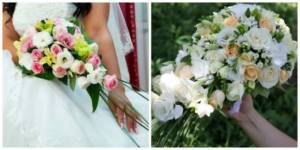
Rod or scepter
It consists of elongated flowers and plants with powerful stems - calla lilies, single-headed roses, eucharis, amaryllis, delphinium. They are assembled using a parallel technique, without crossing each other.
A rather bulky “wand” is usually worn on the bend of the elbow. It is recommended for brides who prefer a formal trouser or skirt suit to a traditional dress.
Florists note that the accessory, reminiscent of a royal sign of power, is suitable only for girls with a strong-willed, purposeful character; in the hands of others it will look ridiculous.
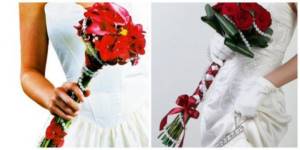
Vegetative composition
It is also called the “ruffled” or European free-form arrangement. Vegetative style is the main trend in modern wedding floristry, striving for natural naturalness and beauty. The plants in the bouquet arrangement should look as if they were still growing in the meadow or garden and had not been touched by human hands.
Such a wedding bouquet has practically no form, in its traditional sense. An asymmetrical arrangement of elements, grouping by type or shade, and pronounced line dynamics predominate. A contrast is required between very large focal buds and small filler inflorescences, openwork and dense greenery, curved and straight plants.
“Rastropysh” is appropriate for a wedding in a rustic and eco-style, boho, Provence, a celebration of a marine, fairy-tale or botanical theme.
Depending on the size and splendor, it will suit both a very petite girl and someone with model height.
Vegetative compositions go well with flowing, loose-fitting dresses, Greek tunics, sundresses and folklore wedding dresses.

Glamelia
A huge artificial flower consisting of many living petals. Assembled using floral glue or wire staples. It looks very elegant and unusual, but is used quite rarely due to the complexity of assembly and fragility.
The first glamelias were made at the end of the 19th century from the petals of gladioli. Florists sought to resemble the camellia, which was popular at that time, hence the name of the technique. Today, the term “glamelia” refers to a wide range of decorative works - from realistic imitation of fresh flowers, to frames lined with petals and fantasy compositions.
Florists do not limit themselves when choosing “donor” plants. For example, giant wedding accessories made from rose buds, called rosamelia, are very popular.
To create you will need:
- approximately 20 single-headed roses;
- technical wire D 0.5 mm;
- floral glue and tape;
- decorative cord;
- a narrow cone made of cardboard, a large bead and a bamboo skewer.
Carefully separate the pink petals from the receptacle. We remove the whole bud, and then divide it into components. We sort them by size: small, medium and large.
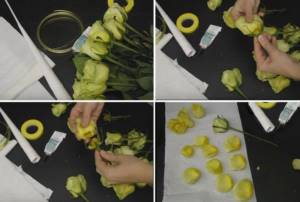
Place the petals on a paper towel and cover it with a damp cloth on top. We cut the wire into fragments 4 and 8 cm long. We bend them, making square pins according to the principle of staples for a stapler. There should be a lot of fasteners - both short and long - to assemble different tiers of rosamelia.
For a whole rose, remove the sepals and outer petals, stopping the tightly closed bud.
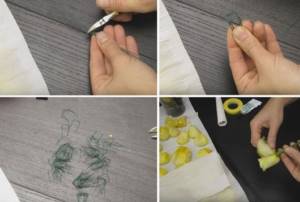
This is the basis of the future rosamelia. Next, we wrap it around a row of medium-sized petals, attaching them to the core with short pins. You can take several pieces at a time to speed up the assembly process and make the decorative flower bouquet more magnificent. Moving away from the center, we take increasingly longer hairpins and larger petals.
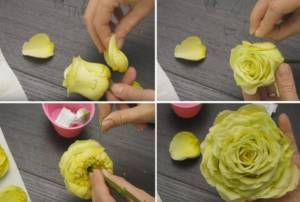
Having assembled the composition of the required volume, we move on to decorating its back part, which is not nearly as beautiful as the front part. We cut out a circle of suitable diameter from thick cardboard and make a hole in it for the rosemelia handle. Glue it to the bottom of the flower and cover the edges with petals.
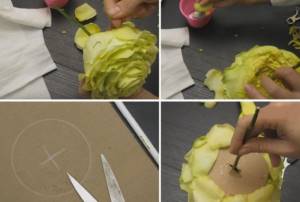
Let's make an analogue of sepals from ivy. We will add a few more branches to the stem of the base rose to gain the desired thickness. Wrap everything with several layers of tape. Roll a long narrow cone out of cardboard.
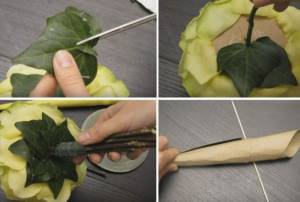
Glue a skewer into it, and attach a bead to its tip with hot glue. The result will be a blank for a spectacular handle. We wrap everything together with tape to align and mask the joints. Then we decorate the handle with a cord of the same shade as the rosemelia.
We put the cone on the stems and fix it at the base of the flower with floral glue.
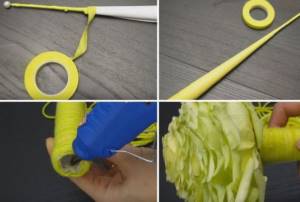
The bride's bouquet, called glamelia, is ready.
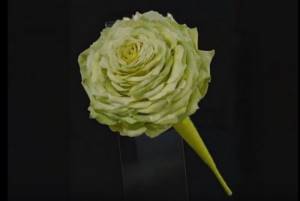
This is what it will look like on your wedding day:
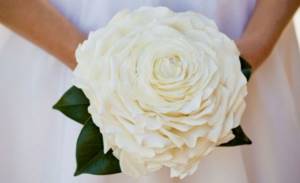
Biedermeier
A variation of the classic round bridal bouquet. It has a characteristic feature: flowers of bright contrasting shades are arranged in layers, forming something like a colorful striped ball. Having appeared in Germany in the middle of the 19th century, Biedermeier firmly won its place on the floristic Olympus and has not left it since then, only slightly changing its appearance.
The most convenient way to collect the “multi-colored ball” is on a porta bouquet holder. A device with a floral sponge already soaked in water is installed in a narrow vase so that the arrangement of a large number of buds does not tip over.
For the lowest tier we take small inflorescences: gypsophila, chamomile or, for example, white bush aster of the Monte Casino variety. We leave the greenery on the stems so that the flower strip becomes very dense, completely covering the piaflora base.
We make the next layer of spray roses “Lovely Lydia” in a rich pink color. Their stems should be slightly shorter than those of the aster and “look” slightly upward.
Using the same principle, we create the next two rings - from purple statice and yellow spray roses of the “Sphinx” variety. The crowning feature is the rainbow Biedermeier stephanotis, the favorite flower of the British royal family. The delicate petals of this plant can suffer from the slightest touch. Therefore, the inflorescences are carefully placed on a pin and, already held by it, are attached to the piaflor.
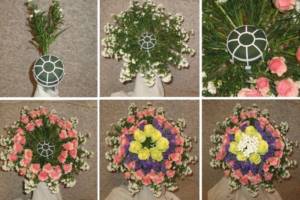
Ball (pomander)
The unusual spherical arrangement, a favorite of creative brides, originates from medieval vessels for fragrant herbs, incense and spices. These small, generously decorated round-shaped accessories that emit a pleasant aroma were designed to protect their owner from numerous infections and hide unpleasant body odors.
Flower pomanders became popular at the beginning of the 20th century. They were used to decorate interiors for various celebrations, including weddings. A little later, the idea arose to use “live” accessories as a bridal bouquet.
The pomander is worn on the elbow or in the lowered hand, holding it by a loop of wide textile tape. It suits graceful girls of short stature in classic-style dresses.
The pomander is based on a ready-made piaflora ball. To attach the holder to it, use a floral wire pin. It is threaded through a knotted ribbon, woven into one rod and taped, and then the ball is pierced and, bending on the other side, the end is inserted back into the piaflor.
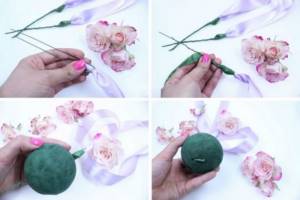
We decorate the sphere, pre-soaked with water, with flowers. For example, bush roses and exotic anigozanthus. Or sprigs of variegated pitosporum.
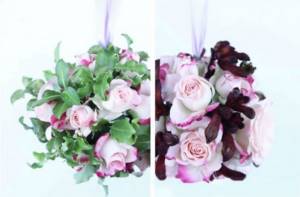
Popular flowers
Any of them can be used in the bride's bouquet, but some of them are especially popular.
- Roses. Roses are a classic. They are considered a symbol of beauty and love, making them ideal for weddings. Roses are used both in single and mixed bouquets.
- Tulips. These delicate spring flowers are usually not combined with other flowers and use minimal or no additional accessories.
- Peonies. Peonies' delicate petals and divine aroma make them an excellent option for wedding bouquets. Peonies are either used to make mono-bouquets, or delicate flowers of pastel shades are added to them, creating lush and at the same time modest bouquets.
- Gypsophila. These small flowers add sophistication to any bouquet. They are used both in more restrained bouquets, for example, combined with roses, and in more relaxed ones, for example with peonies and wildflowers. Mono-bouquets of gypsophila look very gentle.
- Gerberas. These spectacular flowers resemble the sun and add brightness to the bride's look. They are used both in mono bouquets and mixed ones.
- Orchids. Because of their exotic nature, orchids are often used in bridal bouquets to add charm to the look. Climbing orchids are especially popular, allowing you to create cascading bouquets.
- Chamomiles. The simplicity and charm of daisies makes them a popular choice for bridal bouquets. They are either used to make quite large mono-bouquets, or added to other flowers in small quantities.
What flowers should you use to make a bridal bouquet in winter?
Daria Vazhenina:
“In winter, flowers are most often used, which are available all year round, as well as fir branches - brides adore their magical aroma! I would not recommend making a bouquet of white flowers in winter, as they will immediately turn black in the cold. (The most durable flowers suitable for an outdoor photo shoot are scarlet roses. But you need to remember that flowers are delicate creatures, and even 5 minutes of frost will not do them any good.) If, after all, without white flowers in the bouquet and the wedding is not a wedding, purchase for a photo shoot, a duplicate bouquet made of fabric, brooches or polymer clay. It looks impressive, and fresh flowers will remain unharmed.”
Remember that ordering a wedding bouquet is an important issue, and approach it with all responsibility. Look for a florist in advance, and order the bouquet itself no later than 2 weeks before the wedding, optimally a month. Otherwise, the florist will not have time to order flowers for your bouquet, and you will have to choose from what is available in the salon.
The bride's bouquet is a very beautiful accessory that carries the positive energy of the wedding day. Let your bouquet be the most beautiful and lasting! And may you be happy ;))
Originality - how to highlight the image of the bride
Recently, original types of wedding bouquets for the bride made not from real flowers, but from any other materials, have become increasingly popular.
The original ones most often use:
- foamiran;
- from beads;
- feathers;
- beads, rhinestones;
- butterflies from any material;
- ribbons;
- cones;
- corrugated paper;
- fruits and vegetables;
- decorations made of polymer clay (flowers, leaves, butterflies, etc.);
- candies;
- lace;
- buttons;
- shells.
Pomander - ball on a ribbon
Wedding bouquet in the form of a ball on a ribbon or braid. It exudes lightness and ease; such a bouquet is ideal for a soft and light bride. Most often, roses, carnations and chrysanthemums are used in its creation.
pros
- Original appearance.
- Although this bouquet has a frame, it is not heavy at all.
- Easy to make - you can make this bouquet yourself at home.
- Variability in size: a pomander can be either a standard size for a wedding bouquet or very small, and in this case it can serve as a bridesmaid’s bouquet.
Editor's choice: Leap year wedding: is it possible or not?
Minuses
- There is no base for the bouquet, which makes it impossible to pick it up without crushing the flowers.
- Fragility: it is difficult to keep a pomander in its original state for a long time, since it is impossible to touch it without damaging any flower. Therefore, if you suddenly need to put it down, you can immediately say goodbye to the original appearance of the bouquet.
Tips for selection and compilation
- It is important to choose a bouquet that will harmonize with the bride's dress. The smaller the dress, the smaller he should be.
- It is advisable that the flowers cover the bride's waist if she is wearing a dress with a full skirt.
- The bouquet should be comfortable to wear. Brides hold it for a long time, so it is important that it is comfortable to hold.
- Many couples, looking through the varieties of bridal bouquets together, choose flowers that they both like. This gives the bouquet special significance.
When choosing a wedding bouquet, it is important to consider many factors, but the most important thing is that the bride herself likes it and is in harmony with her. Then any, even the simplest bouquet, will become a work of art.
Andrey Andreev
Wedding planner and wedding photography guru
Previous article
Naturalness and natural charm - forest wedding: decoration with striking examples
Next article
How to choose “your” wedding bouquet?
The choice of bouquet depends on many factors:
- budget
- season
- favorite and least favorite flowers
- wedding style
- image of the bride
However, you should start not by choosing a specific form of bouquet, flowers, etc., but by choosing a competent florist who will help you decide on your desires and then make them come true. This is especially true for brides who want an original, designer bouquet for themselves - here EVERYTHING will depend on the professionalism of the florist. Some brides believe that they can even go to the nearest flower stall to pick up a bouquet. However, the choice there is extremely poor, and the storage conditions for flowers leave much to be desired. There is a big risk that the purchased bouquet will not “live” even for a couple of hours.
Daria Vazhenina:
“When choosing “your” florist, pay attention first of all to his work. The type of your bouquet will directly depend on the qualifications and capabilities of the florist. If the master is not professional enough, then by choosing one thing, you may end up getting something completely different. In a good salon, each florist has his own personal portfolio, not a general one. A florist is the same as an artist: he sees differently and treats flowers in a special way. If a specialist knows a lot about flowers and speaks about them with trepidation and care, most likely your bouquet will delight you and will last for more than a day (or maybe more than a week). I also advise you not to forget about the reviews of other brides: read, don’t be lazy. If you find a florist who is your soul mate, then your bouquet will be perfect! The choice of the bouquet itself primarily depends on your preferences, style and theme of the wedding, and your image. Much depends on the character of the bride herself: if she has a bright personality, energy is overflowing, I prefer to emphasize this feature with an unusual bouquet, rather than hide the uniqueness of the girl behind the severity of flowers. Show the florist sketches of wedding decor or examples of design, explain the style and theme of the celebration. Bring with you a photo of your dress (preferably the one you are wearing). The florist will show you approximate options for bouquets and tell you what will suit you best. When choosing a wedding bouquet, listen to your heart. Girls have a very keen sense of nature and intuitively choose the one bouquet that will accompany them throughout their wedding day.”
